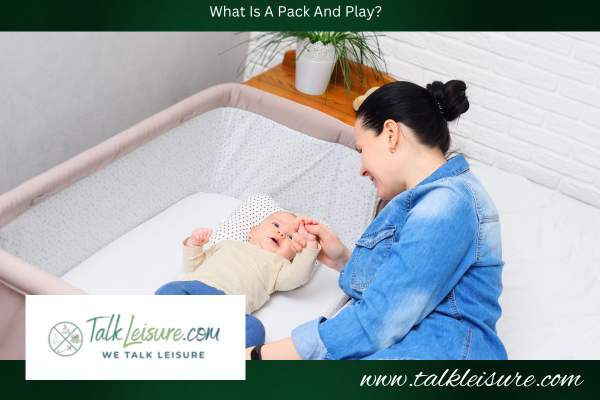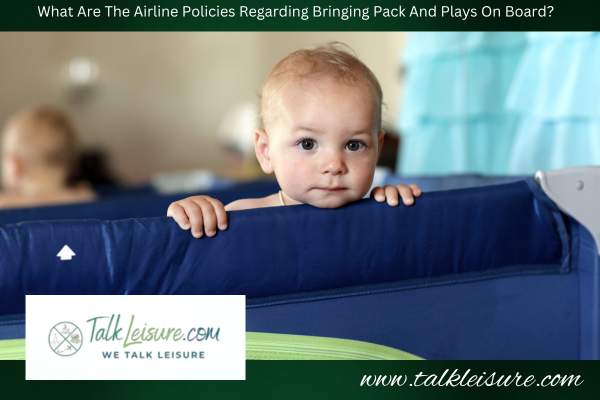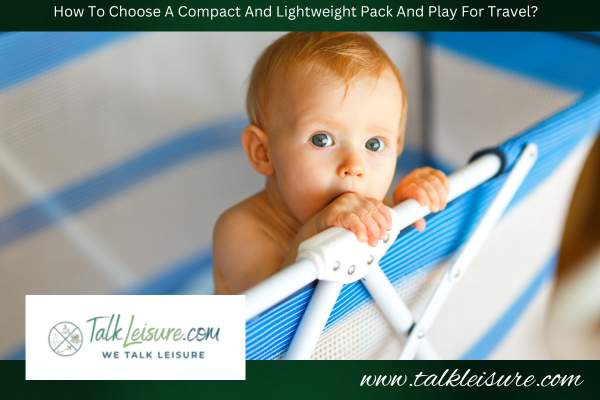Traveling with a baby can be challenging, especially when transporting bulky baby gear.
One common question that parents often ask is whether they can fly with a pack and play.
A Pack and Play can typically be brought on a flight.
However, it is important to pack it according to the airline policies and check on the size restrictions.
This article will explore the FAA regulations regarding flying with baby gear and specifically answer whether a pack and play is allowed on airplanes.
What Is A Pack And Play?

Before we dive into the FAA regulations, let’s first understand what a pack and play is.
A pack and play, also known as a playard or a playpen, is a portable sleeping and playing area designed for infants and toddlers.
It typically features a newborn bassinet, a changing table, and a play area with mesh sides.
Pack and plays are popular among parents for their convenience and versatility, as they can be easily transported and set up wherever needed.
Now that we clearly understand what a pack and play is, let’s explore the FAA regulations on flying with baby gear.
It’s recommended to check with your airline and review their specific policies on traveling with baby gear, including pack and plays, to ensure a smooth travel experience.
Can You Fly With A Pack And Play?

The answer to whether you can fly with a Pack and Play depends on the specific airline’s policies and regulations.
Each airline may have different rules regarding the size, weight, and acceptance of Pack and Plays on board.
It is generally possible to bring a Pack and Play on a flight.
There are a few things to consider, such as the size and weight, whether you can bring it as a carry-on or checked luggage, and the additional fee for oversized or bulky items.
What Are The Airline Policies Regarding Bringing Pack And Plays On Board?

Each airline may have different policies regarding bringing Pack and Plays on board.
When it comes to traveling with a pack and play, it’s important to know the policies of different airlines.
While each airline may have its own specific rules, here are some general guidelines to keep in mind:
1. Size And Weight Restrictions
Most airlines have specific guidelines regarding the size and weight of carry-on items.
When choosing a pack and play for travel, make sure it meets the size requirements to be allowed on board as a carry-on.
2. Carry-On Or Checked Luggage
Some airlines may allow you to bring a pack and play on board as a carry-on, while others may require it to be checked in.
Check with your airline beforehand to understand their specific policies.
3. Additional Fees
Depending on the airline, additional fees may be associated with bringing a pack and play on board or checking it in as oversized luggage.
It’s important to be aware of these fees and factor them into your travel budget.
4. Advance Notice
Some airlines may require you to notify them in advance if you plan to bring a pack and play on board.
Check with your airline and follow their instructions to avoid any inconvenience.
5. Safety Considerations
It’s important to ensure that your pack and play is safe for travel.
Remove any loose parts, secure the mattress, and pack it in a sturdy carrying case to prevent damage during transit.
When flying with a pack and play, it’s always best to check with your specific airline for their policies and guidelines.
This will help ensure a smooth and hassle-free travel experience.
How To Choose A Compact And Lightweight Pack And Play For Travel?

When selecting a pack and play for travel, consider the following factors to ensure that it is compact and lightweight:
Size And Weight
Look for a pack and play specifically designed for travel and lightweight.
Opt for compact and easy-to-fold models, making it convenient to carry and store.
Portability Features
Some pack and play models have additional features that make transporting them easier.
For added convenience, look for features like wheels, carrying handles, and a travel bag.
Durability
Choose a pack and play that is made from high-quality materials and has a sturdy construction.
This will ensure that it can withstand the rigors of travel and last for multiple trips.
Safety Features
Safety should always be a priority.
Look for pack and play models that meet safety standards and have features like a secure locking mechanism and a comfortable and supportive mattress.
User Reviews
Before purchasing, read reviews from other travelers who have used the pack and play for travel.
Their firsthand experiences can provide valuable insights into the product’s performance and suitability for travel.
By considering these factors, you can choose a pack and play that is compact, lightweight, and suitable for travel, ensuring a comfortable and convenient experience for both you and your little one.
What Are The Alternatives That Are Allowed On Planes?

If your pack and play does not meet the size and weight restrictions imposed by the airline, or if you prefer not to travel with it, some alternatives are allowed on planes.
Here are a few options:
Travel Cribs
Travel cribs are popular for parents who want a portable sleep solution for their little ones.
These cribs are designed to be lightweight and compact, making them easier to transport and carry on a plane.
Bassinets
Many airlines provide bassinets for infants on long-haul flights.
These attach to the bulkhead, providing safe and comfortable sleeping space for your baby during the flight.
It’s important to note that bassinets are usually limited in availability and are typically provided on a first-come, first-served basis.
Co-sleepers
Co-sleepers are portable beds that can be placed on adult beds.
These allow parents to sleep alongside their baby while providing a safe and separate sleeping area.
Portable Playards
Portable playards, also known as playpens or playards, are lightweight and collapsible.
They provide a safe and confined space for your child to play or sleep.
Portable playards are typically smaller than traditional pack and plays and may be easier to transport on a plane.
Before purchasing any alternative to a pack and play, it’s essential to check with your airline to ensure that it complies with their specific regulations and requirements.
Reviewing the airline’s policies and guidelines for traveling with infants and young children is recommended to ensure a smooth and hassle-free journey.
Remember, each airline may have different policies and restrictions, so checking with your specific airline before your trip is crucial.
By being well-prepared and knowledgeable about the requirements, you can ensure a stress-free and enjoyable trip with your little one.
Conclusion
In conclusion, flying with a pack and play is generally allowed by most airlines, but there are some important factors to consider.
Before booking your flight, you must check with the airline you’ll be flying with to understand their policies regarding pack and plays.
Some airlines have restrictions or specific guidelines that you need to follow.
Key Takeaways:
Every airline has different size and weight restrictions for both carry-on and checked baggage.
Ensure that your pack and play complies with these limits. Most pack and plays are compact and lightweight, making them suitable for air travel.
Depending on the size of your pack and play, you may have the option to pack it in your checked baggage or carry it on as a separate item. If you decide to carry it on, ensure it meets the dimensions allowed for carry-on items.
Some airlines may have additional fees for carrying bulky or oversized items, including pack and plays.
Be aware of these fees beforehand to avoid any surprises at the airport.
Just like any other baby-related items, your pack and play will need to go through security checks.
Be prepared to take it out of its carrying case if necessary, and allow extra time for the security process.
If you’re flying to a destination where you have access to a pack and play, it might be more convenient to rent one rather than bring it with you.
This will save you the hassle of transporting it and ensure that you have a clean and safe sleeping environment for your child.
Remember always to prioritize your child’s safety and comfort when traveling.
Pack and plays can be a convenient and familiar sleeping option for your little one, whether you’re staying in a hotel or visiting family and friends.
By following the airline’s guidelines and planning, you can enjoy stress-free air travel with your pack and play, ensuring a comfortable journey for both you and your child.
Safe Travels!
Related Posts: Can I Fly With Chocolate?






